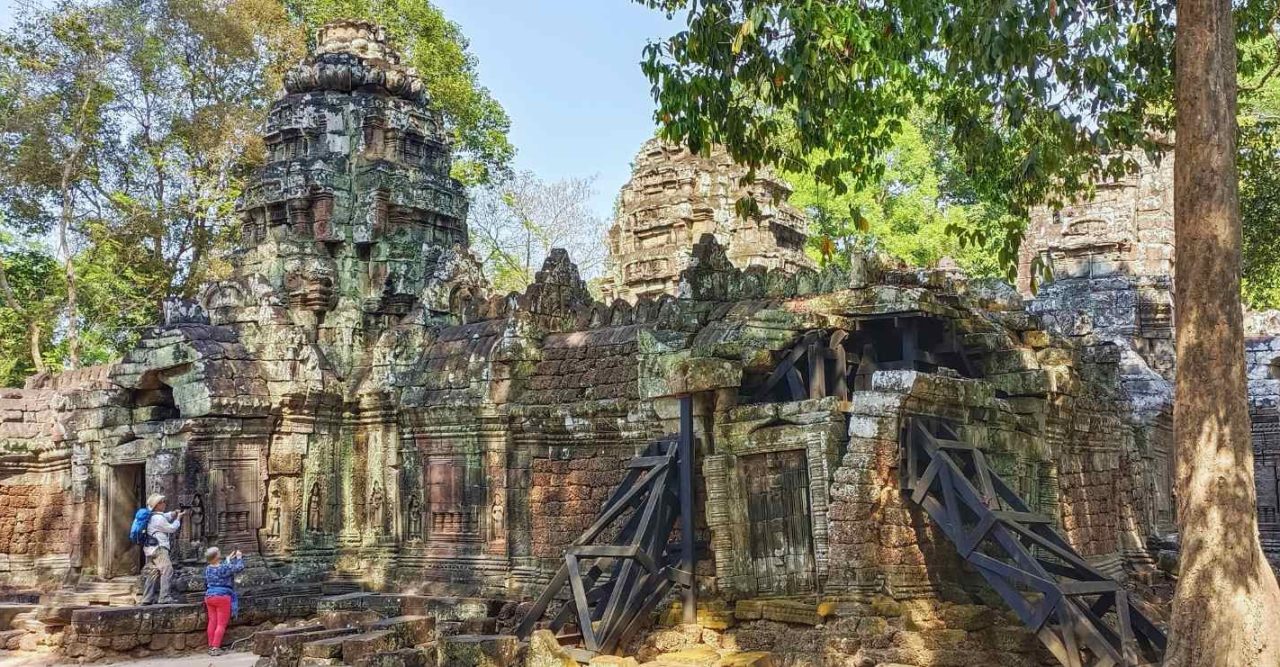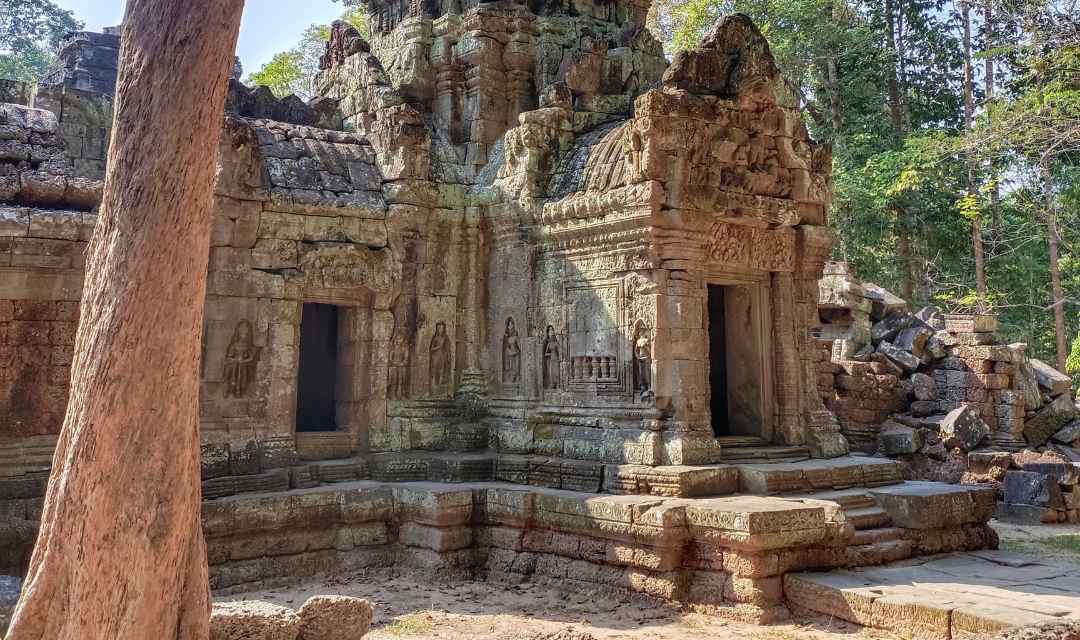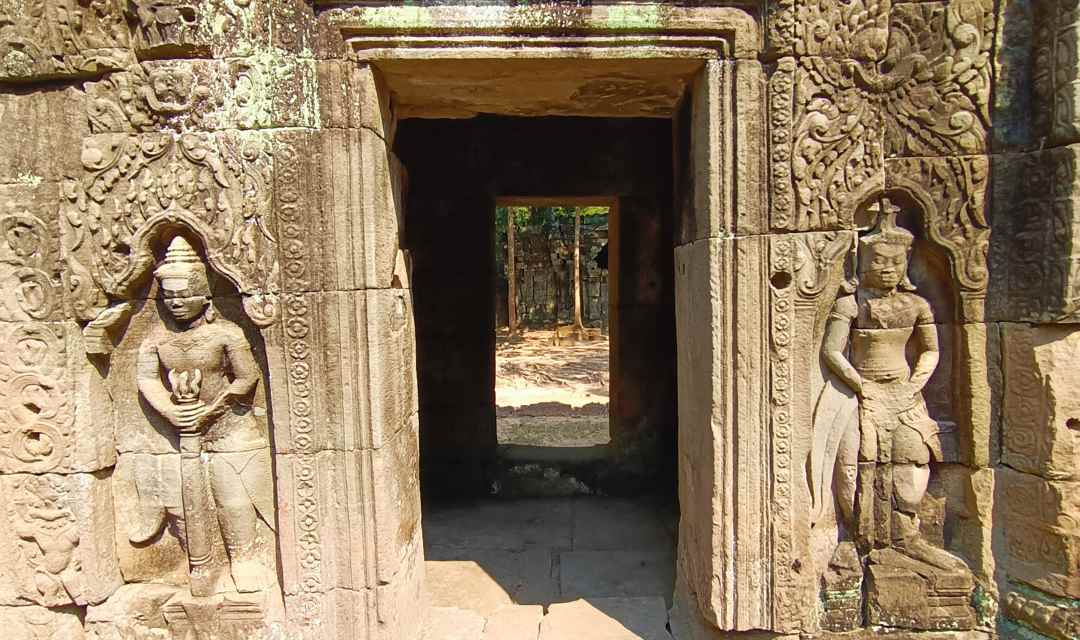Unraveling the Mysteries of Ta Som Temple: A Journey Back in Time
Nestled in the heart of Cambodia, in the city of Siem Reap, lies a hidden gem that has withstood the test of time – the Ta Som Temple. This architectural marvel, built in the 12th century, is a testament to the grandeur of the Khmer Empire under the reign of King Jayavarman VII.
The temple, constructed in the classic Bayon style, is a symbol of the rich cultural heritage and the architectural prowess of the Khmer civilization.
The Architecture of Ta Som Temple
The Ta Som Temple is a fascinating blend of architectural styles, with the Bayon style being the most prominent. The Bayon style is characterized by its intricate carvings, grand towers, and the iconic face towers.
The East and West Gopura Entrance Buildings
Two gopura entrance structures flank the temple, one on the east and the other on the west. These gopuras are not just gateways but are integral parts of the temple, adorned with intricate carvings and sculptures. They serve as a grand welcome to the visitors, setting the tone for the architectural marvels that lie within.
The Large Faces of Lokeshvara on the Gopura
One of the most striking features of the Ta Som Temple is the large faces of Lokeshvara on the gopura. These faces, carved with great precision and detail, exude a sense of calm and serenity. They are a testament to the artistic prowess of the Khmer craftsmen.
The Three Enclosures and a Moat Surrounding the Single Sanctuary Tower
There are three enclosures within the temple complex, each of which has a moat surrounding it. At the heart of these enclosures stands a single sanctuary tower, a characteristic feature of the Bayon style. This layout is symbolic of the Hindu cosmology, representing the cosmic mountain Meru.
The Hindu and Buddhist Depictions on the Lintels and Pediments
The lintels and pediments of the temple are adorned with depictions from Hindu and Buddhist mythology. These carvings not only add to the aesthetic appeal of the temple but also provide a glimpse into the religious beliefs and practices of the Khmer civilization.
Embarking on a journey to explore the Ta Som Temple is like stepping back in time. Whether it’s the 1-day Angkor Wat Grand Loop private tour or the Siem Reap 2-day tour, each offers a unique opportunity to delve into the rich history and culture of Cambodia.
For those who wish to witness the mesmerizing sunrise at Angkor Wat, the Angkor Wat Sunrise Tour is a must. And for a more comprehensive experience, the Ta Nei Opening Time Tour is highly recommended.
So, are you ready to embark on this journey back in time and explore the timeless marvel that is the Ta Som Temple?
The Restoration of Ta Som Temple
Imagine a temple, once lost in the clutches of the jungle, now standing tall, narrating tales of its glorious past. That’s the story of the Ta Som Temple. In the 1930s, the temple was almost hidden under a thick cover of jungle vegetation.
But, like a phoenix rising from the ashes, it underwent a transformation that brought it back to life.
The World Monuments Fund played a pivotal role in this restoration process. Their relentless efforts ensured that the temple was not only preserved but also regained its lost glory. So, how did they do it? Let’s find out!
- Clearing of Jungle Vegetation: The first step was to free the temple from the clutches of the jungle. This was no easy task. It required meticulous planning and execution. But the result? A temple that was once lost, now stood revealed in all its glory.
- Preservation Efforts: The World Monuments Fund didn’t stop at just clearing the vegetation. They went a step further. They worked tirelessly to preserve the temple, ensuring that it stood as a testament to the architectural prowess of the Khmer civilization.
Exploring Ta Som Temple
Now that we’ve uncovered the temple’s past, let’s embark on a journey to explore its present. The Ta Som Temple is a labyrinth of enclosures, each with its unique features. Ready for the adventure? Let’s dive in!
- The Outer Enclosure: As you step into the temple, the outer enclosure welcomes you. It’s like the cover of a book, giving you a glimpse of the stories that lie within.
- The Moat and the Second Enclosure: Cross the moat, and you find yourself in the second enclosure. It’s like stepping into a different world, a world where time seems to have stood still.
- The First Enclosure and the Central Sanctuary: As you move further, you reach the first enclosure and the central sanctuary. This is the heart of the temple, pulsating with tales of the past.
- The Two Library Buildings: The temple also houses two library buildings. They stand as a symbol of the knowledge and wisdom of the Khmer civilization.
- The Single Cruciform Sanctuary: The single cruciform sanctuary is the crown jewel of the temple. It stands tall, narrating tales of the temple’s glorious past.
So, are you ready to embark on this journey of exploration? Remember, every stone has a story to tell, every carving a tale to narrate. All you need to do is listen!
Now, isn’t that a journey worth embarking on?
And guess what, you don’t have to do it alone.
With My Siem Reap Tours, you can explore the Ta Som Temple and many more such marvels in the company of expert guides. So, what are you waiting for?
1-day Angkor Wat GRAND LOOP Private tour with air-con minivan [with the famous Banteay Srei temple]
The Mystery and Beauty of Ta Som Temple
Every temple has a story to tell, but the Ta Som Temple? It’s a mystery wrapped in an enigma. From the tree overgrowing the East gopura to the defaced depictions of Buddha, every aspect of the temple adds to its allure. But what makes it truly unique? Let’s unravel the mystery!
The Tree Overgrowing the East Gopura
Imagine a tree, its roots entwined with the stones of a temple, almost as if they are one. That’s the sight that greets you at the East gopura. This tree, with its roots cascading down the temple walls, is a sight to behold.
- It’s a testament to the resilience of nature and the passage of time.
- It’s as if the tree and the temple are locked in an eternal embrace, each lending the other a unique charm.
The Defaced Depictions of Buddha
As you explore the temple, you’ll come across defaced depictions of Buddha. These defaced depictions, rather than diminishing the temple’s beauty, add to its mystery.
- They make you wonder about the stories they could tell, the secrets they hold.
- They stand as silent witnesses to the temple’s past, each defacement a chapter in its history.
The Experience of Visiting Ta Som Temple
Visiting the Ta Som Temple is not just about exploring an ancient monument.
- It’s about immersing yourself in its mystery, its beauty.
- It’s about walking through its corridors, listening to the whispers of the past.
- It’s about standing under the tree at the East gopura, feeling the weight of centuries.
- It’s about looking at the defaced depictions of Buddha, wondering about the tales they could tell.
Ta Som Temple – Frequently Asked Questions
As you delve into the mysteries of the Ta Som Temple, you’re bound to have questions. And guess what? You’re not alone! Here are some of the most frequently asked questions about the temple and the Angkor Archaeological Park:
What is the significance of the Bayon style in Khmer architecture?
The Bayon style is a distinctive architectural style found in Khmer temples, particularly in the Bayon Temple at Angkor, Cambodia. Here are some significant features of the Bayon style:
- Baroque style: The Bayon style is known for its rich decoration and intricate carvings, which are considered the most spectacular manifestation of the baroque style of Khmer architecture.
- Buddhist influence: The Bayon Temple is the first and only Buddhist temple constructed by the Angkor (Khmer) Empire2
- The temple’s bas-reliefs depict important events like battles and pictures of everyday life, providing viewers with an idea of life in Cambodia during the 12th and 13th centuries.
- Faces: The most distinctive feature of the Bayon style is the large stone faces carved into the temple’s towers. The temple has 54 towers, each with four faces, which are thought to represent the all-seeing eyes of the Buddha or the king.
- Jayavarman VII: The Bayon Temple was built in the late 12th or early 13th century as the state temple of the King Jayavarman VII5
- . Jayavarman VII was a Buddhist king who constructed more temples than any other king in Cambodia’s history.
Overall, the Bayon style is significant for its unique blend of Buddhist and Hindu influences, its rich decoration, and its distinctive stone faces.
What other temples are located on the grand circuit at Angkor?
The Grand Circuit at Angkor is a popular route that covers several major temples outside of Angkor Thom. Here are some of the temples located on the Grand Circuit, according to the search results:Preah Khan
- Neak Pean
- Ta Som
- East Mebon
- Pre Rup
Other temples that may be included on a Grand Circuit tour, depending on the guide or tour company, include Banteay Prei and Srah Srang. Visitors can explore these temples and their surroundings, which include moats, forests, and other historical sites.
Ta Som Temple – Key Takeaways
- Location: Ta Som is located northeast of Angkor Thom and just east of Neak Pean.
- Design: The layout of the temple is simple, with just one shrine on a flat floor inside the laterite walls of the enclosure. It has a moat in the center and three laterite walls surrounding it, with two sets of gopura (entry ways) puncturing the walls on opposite sides. The gopuras take the form of a cross, with a tiny room on each arm and windows adorned with balusters. The gopura’s central construction features four Bayon-style faces.
- Purpose: Little is known about the purpose of Ta Som, but it may have been dedicated to the King’s father as a hospital or a resting place for pilgrims.
- Size: Ta Som is a medium-sized temple in the Bayon style, which means it’s a Buddhist monument from the late 12th century.
With My Siem Reap Tours, you can explore the Ta Som Temple and many more such marvels in the company of expert guides.


